Situated near the core of the Okavango Delta, north of Moremi Game Reserve, lies a Botswanan institution: Ker & Downey’s Shinde Camp. The treehouse-like structure is built under a canopy of ebony, water-fig and mangosteen trees and sits on the edge of the Shinde Lagoon, seemingly untouched by the drought that has gripped Botswana for over a year.
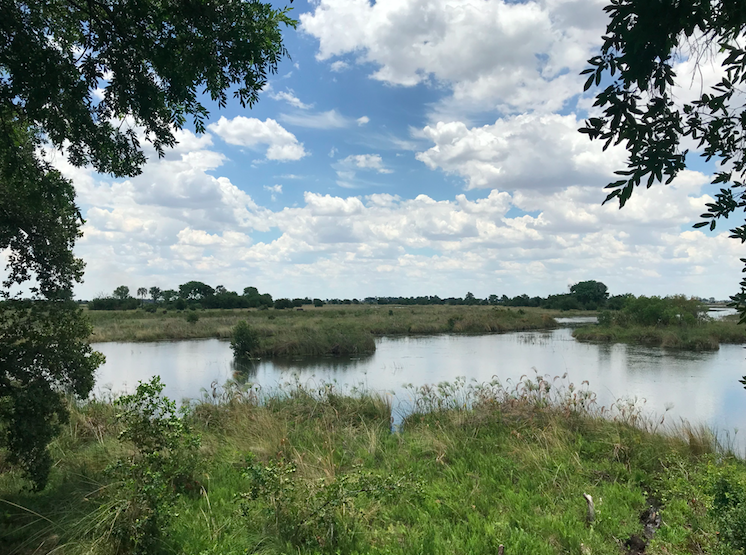
The view of the Shinde Lagoon from the dining area. Image: Imogen Searra
Shinde, meaning ‘tree squirrel’ in Setswana, is bursting with birdlife in late November. Not a minute goes by without the call, song or sound of one of the 595 bird species found in Botswana. The communal area of Shinde is modelled like a treehouse, with multi-level platforms which are connected by a series of polished teak steps and ramps, immersing you among the boughs. From top to bottom, the different levels comprise the dining area, reading corner and boma that trails off toward the tented camps, a private enclave and finally the swimming pool. Shinde has a high fence to keep out elephants but other animals like cats and hyenas can get into the property.
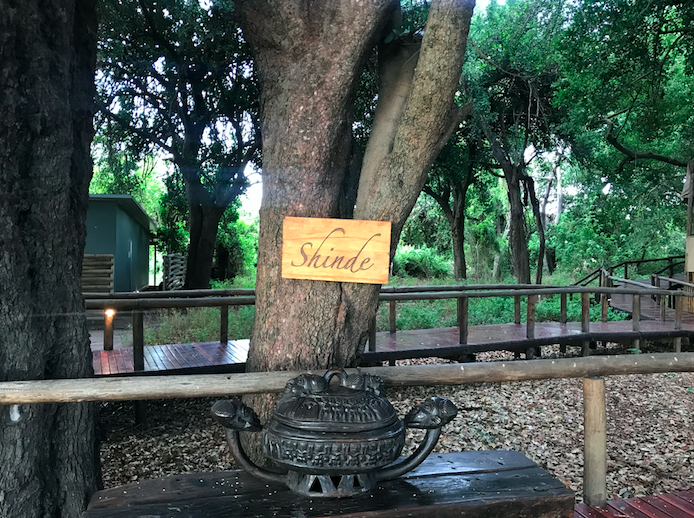
The open-air entrance to Shinde Lodge. Image: Imogen Searra
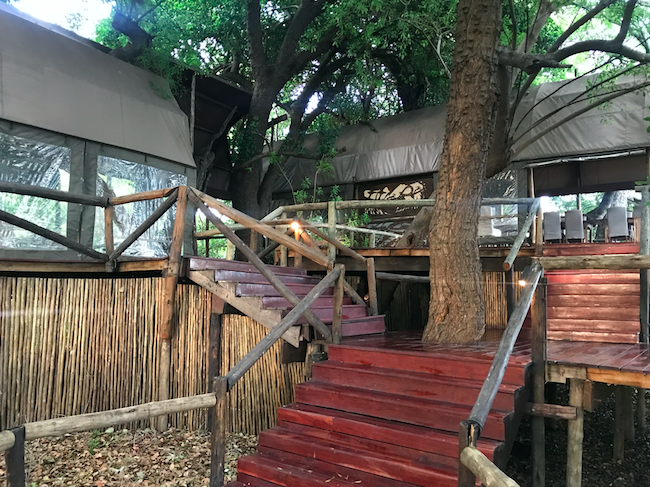
The feeling of being in a treehouse is irrepressible at Shinde Lodge. Image: Imogen Searra
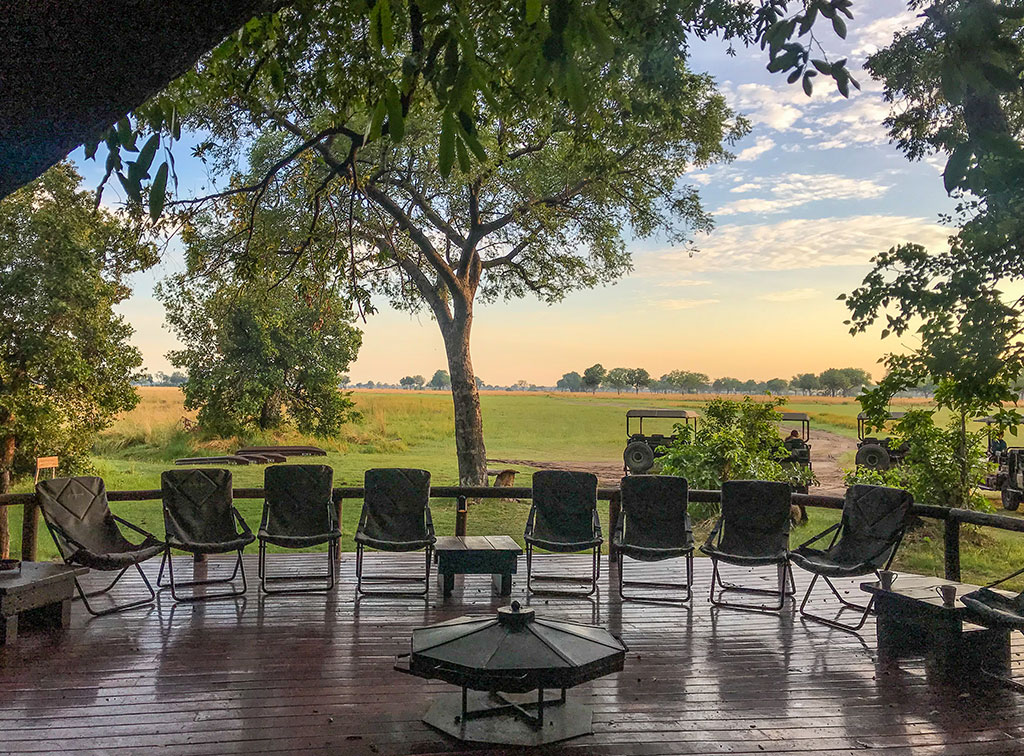
Sunrise at the boma. High tea is served here before an afternoon drive. Image credit: Imogen Serra
When our group arrived we were given a briefing on the surrounds, the structure of our itinerary and what activities were available. The staff then enquired about our dietary requirements. When travelling, more often than not, plant-based folk like myself have low expectations. When breakfast, lunch and dinner time roll around, my worst expectations are often proven right.
I reluctantly raised my hand and explained that I don’t eat meat or dairy. The General Manager didn’t bat an eyelid and jotted my requirements down.
Food is an important part of any travel experience and I was gratefully gobsmacked by the delectable meals that the kitchen staff at Shinde whipped up for me. From delicious, stuffed gem squash and a chickpea and mushroom curry – to my very own ‘cheese’ sauce and an array of alternative milk options, Shinde caters for a wide range of dietary needs – in style. Important details like this contributed to my incredible experience at the lodge.
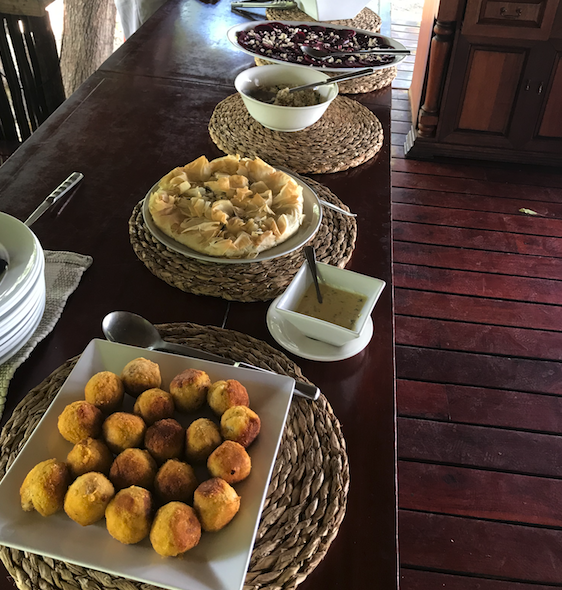
Voila! Lunch is served: fish cakes, spinach phyllo pastry and sliced beetroot salad. Image: Imogen Searra
On the first morning game drive, my guide Kenny shared a wealth of information that reinforced my belief that every day in the bush is like a school day: there is always something new to learn. From his knowledge on osprey, to knowing the collective noun for a marabou stork (a funeral), my experience of the birdlife at Shinde was exceptional all thanks to Kenny. Seeing multiple breeding pairs of the endangered wattled crane was the highlight of this sublime experience.
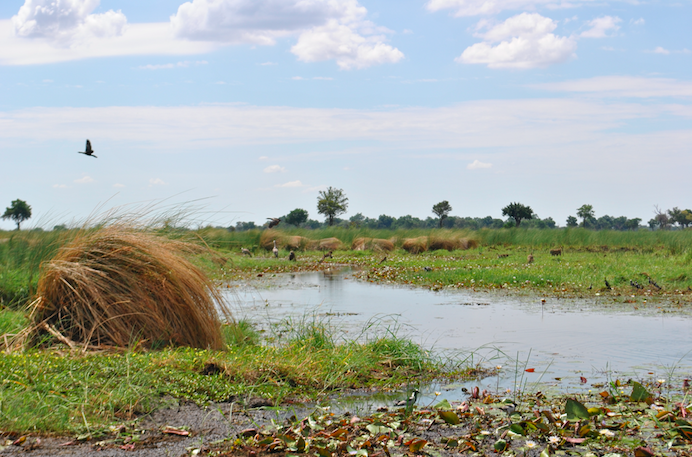
Wattle cranes, a blacksmith lapwing and browsing baboons. Image: Imogen Searra
An iconic way to experience the Okavango Delta is of course from the seat of a mokoro. In the past, mokoro boats were carved from either jackalberry, sausage trees or sycamore figs. Today these canoes are made from fibreglass, in an effort to conserve the natural environment.
A mokoro made from a tree lasts around 5 years and yet the trunk from which it’s carved needs multiple times this period to grow big enough to produce a canoe. After we were briefed and assured that the boats wouldn’t tip so long as we weren’t too active, we stepped into the mokoro and slipped across the Shinde Lagoon.
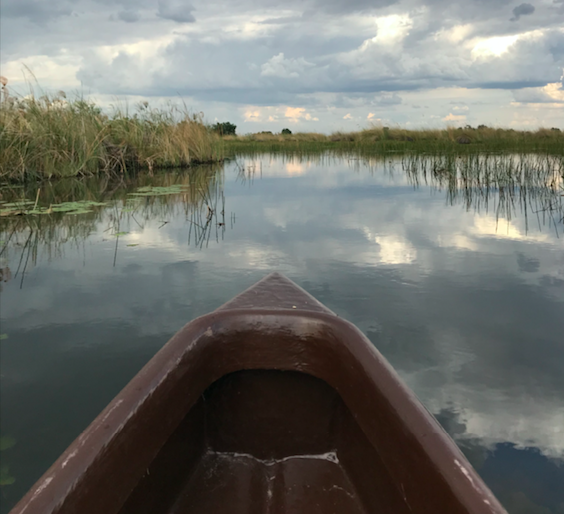
My fibreglass mokoro gliding down the Shinde Lagoon. Image: Imogen Searra
Being on the mokoro was the most tranquil experience of my life. Passing through the water, over lily pads, alongside towering reeds and with a light drizzle overhead: it was the epitome of relaxation. My ears tuned into the sound of the guide’s ngashi (pole) gliding through the water while pushing the mokoro forward. My guide informed me that mokoros don’t go deeper than 1.5 metres so as to avoid a hippo from launching and flipping the boat. Twenty minutes later we were riverside enjoying our last sundowner.
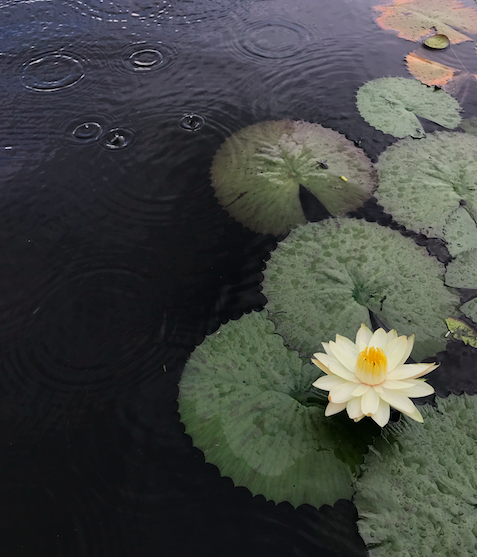
Lily pads and raindrops. Image: Imogen Searra
When we arrived back at Shinde, I returned to my room to freshen up for dinner. The tent I stayed in was a massive canvas and wooden structure that can comfortably sleep two. It’s equipped with an ensuite bathroom, seating area, cupboards and a viewing deck overlooking the floodplains. Shinde also has an enclave for larger groups or families that acts as private accommodation, with its own dining area, viewing deck and kitchen. Other guests staying at Shinde are not permitted to enter the enclave but those staying in the enclave can make use of any of the camp’s facilities.
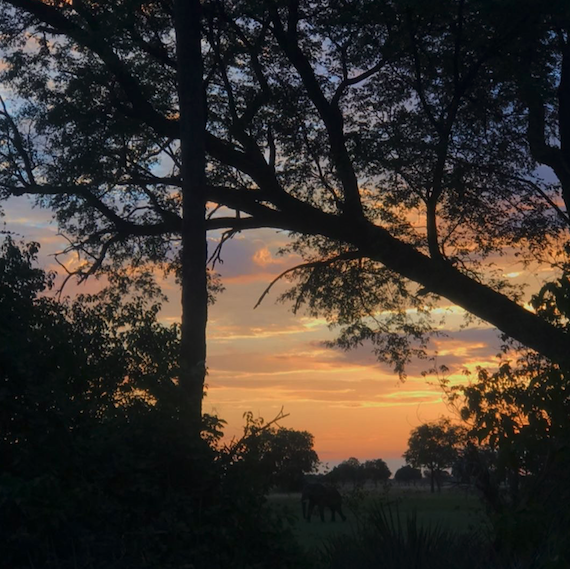
A view of the sunrise from my tent. Image: Imogen Searra
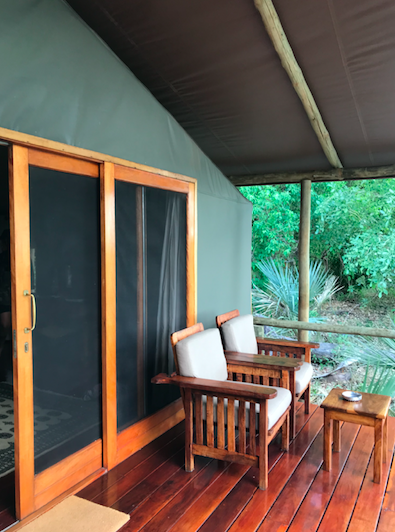
The deck and entrance to tent number 4. Image: Imogen Searra
After freshening up, all the guests congregated at the boma. No one was staying at the enclave and so we spent our last evening having dinner on the private deck. A feast was served and as the conversation flowed we reached a group consensus that this lodge provides an exceptional experience.
On the final morning game drive, Kenny took the other guests and I on a birding adventure that I’ll never forget. We spotted woodlands kingfishers galore and a breeding pair of the highly endangered southern ground hornbill. Finally, we stopped at a watering hole that was slowly drying up but teeming with birds. Kenny explained that the catfish in the water was the cause of such a large number of birds in one place. The fish feast was an extraordinary sighting.
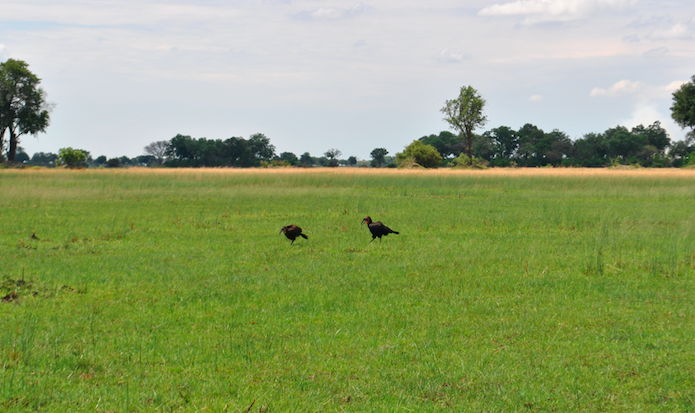
A breeding pair of the endangered southern ground hornbill. Image: Imogen Searra
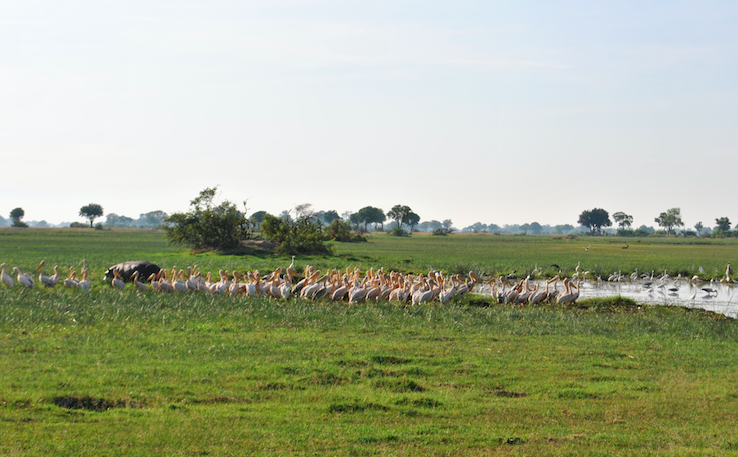
The fishy feast. Image: Imogen Searra
We returned to camp roughly an hour before my flight was due to depart. The staff at Shinde organized breakfast in the bush, near the airstrip. We sipped on hot coffee while the chefs cooked up a regal feast. We all ate together and discussed the highlights of the trip.
Leaving Shinde was a heart-wrenching affair, I wasn’t ready to move on and yet the aircraft was waiting.
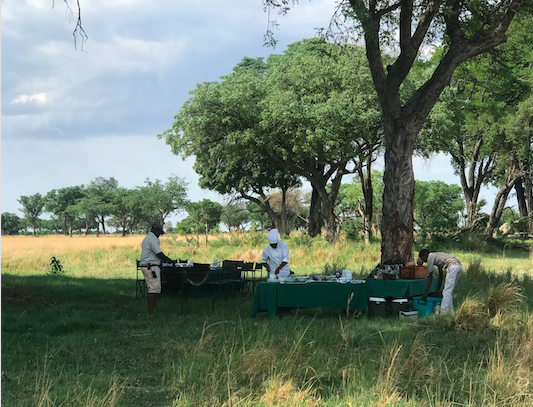
A special surprise: breakfast in the bush. Image: Imogen Searra
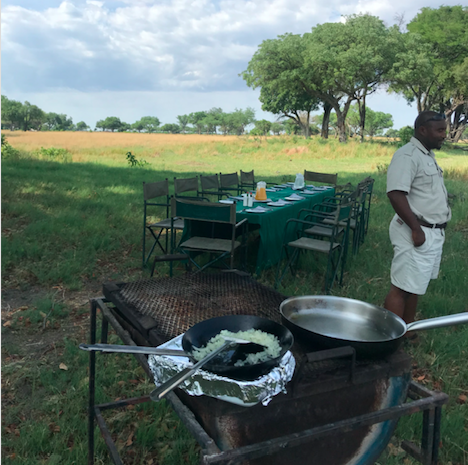
Kenny spent breakfast with the group, furthering the inclusive dynamic of Shinde. Image: Imogen Searra
From the mokoro, to breakfast in the bush, night drives and siestas under the massive trees, I was completely taken aback by the beauty of the Okavango Delta and how Shinde showcases it. The Okavango Delta has been on my bucket list since I can remember. If it’s on yours too then I highly recommend ticking it off at Shinde. Currently, Shinde is undergoing a revamp and will reopen on 1 June 2020.
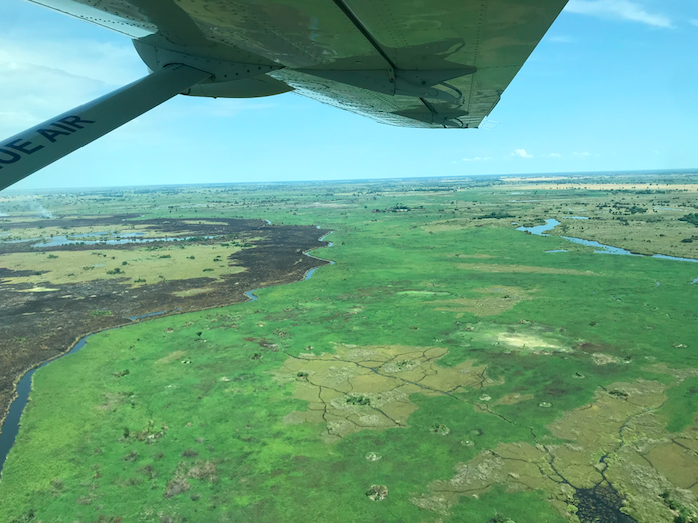
The Okavango Delta from the sky. Image: Imogen Searra
Shinde is eco-tourism certified and is situated on a private concession, offering land and water activities. Generally, there is water throughout the wet and dry season and so the boat safari and mokoro activities can be enjoyed all-year-round. Shinde has no WiFi but there is a laptop with a LAN cable for those who cannot disconnect from the outside world.
Cost: prices start at R7,635 per person sharing for 2019. Contact Shinde on +267 686 1282 or +267 7577 5300 or via email [email protected] for 2020 rates.
Image: Imogen Searra
You may also like
Related Posts
Gabrielle Jacobs forsakes the Breede Valley’s winelands for some Cape nature at Vrolijkheid Nature Reserve,15km...
read more